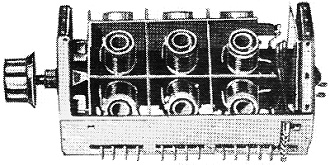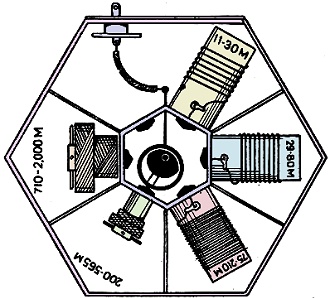|
February 1935 Short Wave Craft
 [Table
of Contents] [Table
of Contents]
Wax nostalgic about and learn from the history of early electronics. See articles
from Short Wave Craft,
published 1930 - 1936. All copyrights hereby acknowledged.
|
"All-wave" radios were
all the rage in the 1930s. Such technological marvels (they truly were back in the
day) gave listeners access to not just local commercial broadcasts, but to radio
stations around the world. Farm families and suburb dwellers suddenly became nouveau
cosmopolitans. It was akin to how the Internet, aka the "Information Superhighway,"
provided on-demand access to stored data in the 1990s. "Onramps" like RF Cafe provided
organized, classified venues for the teeming masses. But, I digress...
Not only were new radios being designed as all-wave, but tuning kits were sold
for radio service shops to retrofit existing sets. Covering such a wide spectrum
of tuning required banks of selectable inductors and capacitors. Supplying a one-size-fits-all
module required adequate shielding and isolation to minimize coupling to and from
the all-wave tuner. This unit was featured at the 1934 Paris Radio Exhibition. My
1941 Crosley Model 03CB console radio is an all-wave type.
The Paris Radio Exhibition

In the recent French Radio Exhibition, the "all-wave" tuning
coil system illustrated above was shown, the coils being placed in separate shielded
compartments.
By C.W. Palmer
We have reviewed in these columns the radio shows which were held, this year
at Olympia, in England, and at Berlin, Germany. And now we have the eleventh annual
show held in Paris, at the Grand Palais.
While the number of short-wave items appearing at this show is less numerous
than at the other two shows, several really novel and worthwhile items have been
displayed in French magazines describing the show.
The first of these is a spiral dial with a traveling pointer which follows the
spiral, as shown in the sketch, here. This automatically produces a vernier tuning
action, due to the unusual length of the tuning scale, but also permits notations
and loggings to be made directly on the scale, which is extremely useful for the
short-wave receiver. The tuning can be accomplished either with a dial or crank
at the end of the scale, as shown, or a cable drive could be attached to permit
a knob to be used.


The lower drawing in the group above shows the arrangement of
the Cam switch used in the new French all-wave tuning coil assembly, while the upper
picture shows the new French spiral dial with a traveling indicator which follows
the spiral.
The second item is an interesting al-wave tuning system, which has coils arranged
in a circle, in individually shielded compartments, and a cam switch (differential)
included as an integral part of the assembly to permit shifting from one band to
another. The arrangement permits the coils to be completely shielded, and still
maintain exceptionally short leads, and the switch, which is usually the stumbling
block in such complicated set-ups is actually more simple and more positive than
most wave-change arrangements.
Another advantage of this system of all-wave receiver coil construction is in
the flexibility - in the matter of how many coils can be included. In the arrangement,
any desired number of coils can be switched in at the same time, to cover the number
of tuned circuits required by the circuit. This is shown in the photo here which
shows a unit having 3 sets of coils.
Practically all the receivers shown at the Paris show, according to Toute la
Radio, that lively little French magazine, are superheterodynes, while considerable
effort has been shown by manufacturers to improve the external appearance of the
sets. There are quite a number of A.C.-D.C. models in evidence, though the majority
are A.C. operated. Sets of the D.C. type were notable by their absence.
Goodbye Eiffel Tower
When the Lucerne agreement was signed the wavelength plan provided no channel
for the Eiffel Tower station, and everyone assumed that it would be closed down
forthwith. However, it just went on broadcasting and helping to make yet more chaotic
the chaos that prevailed in Europe.
Some months ago it was announced that the Eiffel Tower was immediately to cease
operations on the long waves and blossom out as a short-wave broadcaster.
Once again nothing happened; the Eiffel Tower just carried on as before. Now,
the Minister of Posts and Telegraphs has at last taken charge. He announced a short
time ago that the Eiffel Tower was clearly superfluous as a broadcasting station
and that it was causing a great deal of unnecessary interference. It must be closed
down and used in the future only for occasional experimental transmissions.
M. Mallarme, the Minister of Posts and Telegraphs seems to be a man of his word,
for according to Popular Wireless, the station has not been heard since, though
there is some speculation in the above magazine that the station will pop up again
on the long waves. The old Eiffel Tower seems like King Charles, to be "an unconscionable
time a-dying."
Posted January 30, 2024
(updated from original
post on 5/19/2017)
|































